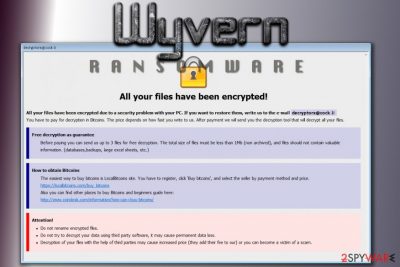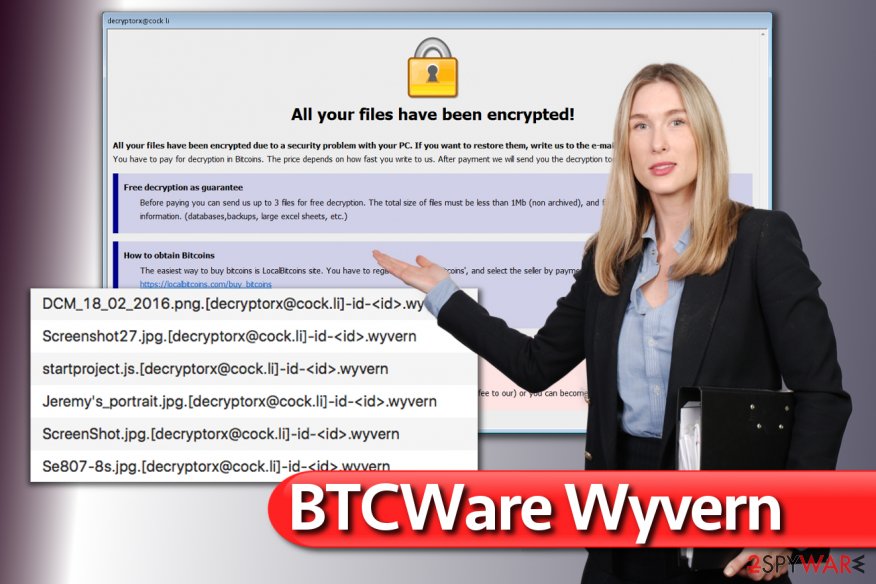Wyvern ransomware / virus (Decryption Steps Included) - Free Guide
Wyvern virus Removal Guide
What is Wyvern ransomware virus?
BTCWare cybercrime gang releases Wyvern ransomware variant

Wyvern virus is a variant of BTCWare ransomware, a malicious program that has been making rounds on the Internet for more than six months. BTCWare Wyvern ransomware has emerged on September 21st, replacing the previous version known as Nuclear.[1] The malware sneaks into victim’s computer using Trojan deception technique and encrypts all files using sophisticated encryption ciphers.
Just like previous BTCWare versions, Wyvern malware was named after the extension it uses to mark encrypted files. While scanning the system and looking for target data to encode, it also appends a specific extension after the original file extension. The extension typically matches this pattern:
.[email address]-id-[victim’s ID].wyvern
The current variant of Wyvern virus uses .[decryptorx@cock.li]-id-.wyvern extension for encrypted files. The email address provided in the extension is also presented in the ransom note, which the virus creates and saves in every folder containing some encrypted data.
The criminals want the victim to contact them via decryptorx@cock.li so that they could present the price of the decryption tool that can restore all files back to their initial state. That is nothing else but extortion, and we do not recommend paying the ransom.
Besides, trusting cyber criminals’ promises would be a bad idea because they can simply take your money and vanish without a trace. You won’t be able to track the criminals even if you pay because they only accept the payment in Bitcoin (cryptocurrency).
If your files were encrypted, we strongly recommend you to remove Wyvern virus first. Then you can use the data recovery instructions we added at the end of this article. Although the provided options might not necessarily help you to recover your files, it cannot hurt to try.
For Wyvern ransomware removal you should choose and install a powerful malware removal software (in case you did not have one before). Our team suggests using FortectIntego or SpyHunter 5Combo Cleaner. Before you attempt to launch these programs, restart your PC in a Safe Mode (follow the directions added to this article).

Distribution techniques used to spread BTCware ransomware variants
BTCware ransomware samples are usually distributed via Blank Slate spam, a technique that is also used for Cerber and Locky ransomware distribution[2]. In other words, you can receive Wyvern, Nuclear or Aleta malware after opening a malicious file attached to an email that has an empty subject line and delivers no message.
Stay away from such attachments because opening them is equal to pushing a button that says “infect your computer now.” Usually, the attachment is a ZIP file with a JS or VBS file inside of it. The file itself isn’t ransomware, but opening it activates a code inside of it that is set to connect to the remote domain and download malware from it.
The code also executes the file as soon as the download is complete. Zondervirus.nl experts report[3] that .wyvern file extension virus uses a strong cipher to take files hostage, and without a data backup, data recovery might be impossible.
Remove Wyvern ransomware and recover encrypted files
Once ransomware compromises a computer, it is no longer safe to use it, so remove Wyvern virus without a wait. We strongly recommend using an anti-malware program to complete this task.
Manual ransomware removal is technically possible, but to perform it in real life you have to be an IT expert and know where ransomware tends to hide its files. Each virus is different, so we strongly recommend choosing a trustworthy anti-malware solution to cleanse your computer.
You can find comprehensive Wyvern removal guidelines down below. These directions will help you to prepare your PC for malware removal.
Getting rid of Wyvern virus. Follow these steps
Manual removal using Safe Mode
Delete BTCWare Wyvern ransomware professionally: reboot your PC into Safe Mode with Networking to disable active malicious processes and then let your anti-malware software do its job.
Important! →
Manual removal guide might be too complicated for regular computer users. It requires advanced IT knowledge to be performed correctly (if vital system files are removed or damaged, it might result in full Windows compromise), and it also might take hours to complete. Therefore, we highly advise using the automatic method provided above instead.
Step 1. Access Safe Mode with Networking
Manual malware removal should be best performed in the Safe Mode environment.
Windows 7 / Vista / XP
- Click Start > Shutdown > Restart > OK.
- When your computer becomes active, start pressing F8 button (if that does not work, try F2, F12, Del, etc. – it all depends on your motherboard model) multiple times until you see the Advanced Boot Options window.
- Select Safe Mode with Networking from the list.

Windows 10 / Windows 8
- Right-click on Start button and select Settings.

- Scroll down to pick Update & Security.

- On the left side of the window, pick Recovery.
- Now scroll down to find Advanced Startup section.
- Click Restart now.

- Select Troubleshoot.

- Go to Advanced options.

- Select Startup Settings.

- Press Restart.
- Now press 5 or click 5) Enable Safe Mode with Networking.

Step 2. Shut down suspicious processes
Windows Task Manager is a useful tool that shows all the processes running in the background. If malware is running a process, you need to shut it down:
- Press Ctrl + Shift + Esc on your keyboard to open Windows Task Manager.
- Click on More details.

- Scroll down to Background processes section, and look for anything suspicious.
- Right-click and select Open file location.

- Go back to the process, right-click and pick End Task.

- Delete the contents of the malicious folder.
Step 3. Check program Startup
- Press Ctrl + Shift + Esc on your keyboard to open Windows Task Manager.
- Go to Startup tab.
- Right-click on the suspicious program and pick Disable.

Step 4. Delete virus files
Malware-related files can be found in various places within your computer. Here are instructions that could help you find them:
- Type in Disk Cleanup in Windows search and press Enter.

- Select the drive you want to clean (C: is your main drive by default and is likely to be the one that has malicious files in).
- Scroll through the Files to delete list and select the following:
Temporary Internet Files
Downloads
Recycle Bin
Temporary files - Pick Clean up system files.

- You can also look for other malicious files hidden in the following folders (type these entries in Windows Search and press Enter):
%AppData%
%LocalAppData%
%ProgramData%
%WinDir%
After you are finished, reboot the PC in normal mode.
Remove Wyvern using System Restore
-
Step 1: Reboot your computer to Safe Mode with Command Prompt
Windows 7 / Vista / XP- Click Start → Shutdown → Restart → OK.
- When your computer becomes active, start pressing F8 multiple times until you see the Advanced Boot Options window.
-
Select Command Prompt from the list

Windows 10 / Windows 8- Press the Power button at the Windows login screen. Now press and hold Shift, which is on your keyboard, and click Restart..
- Now select Troubleshoot → Advanced options → Startup Settings and finally press Restart.
-
Once your computer becomes active, select Enable Safe Mode with Command Prompt in Startup Settings window.

-
Step 2: Restore your system files and settings
-
Once the Command Prompt window shows up, enter cd restore and click Enter.

-
Now type rstrui.exe and press Enter again..

-
When a new window shows up, click Next and select your restore point that is prior the infiltration of Wyvern. After doing that, click Next.


-
Now click Yes to start system restore.

-
Once the Command Prompt window shows up, enter cd restore and click Enter.
Bonus: Recover your data
Guide which is presented above is supposed to help you remove Wyvern from your computer. To recover your encrypted files, we recommend using a detailed guide prepared by 2-spyware.com security experts.If your files are encrypted by Wyvern, you can use several methods to restore them:
Data Recovery using special software
There are some useful programs that might help you to recover .wyvern file extension files. One of them is Data Recovery Pro.
- Download Data Recovery Pro;
- Follow the steps of Data Recovery Setup and install the program on your computer;
- Launch it and scan your computer for files encrypted by Wyvern ransomware;
- Restore them.
No ways to fully recover files as decryption tool isn't available (at the moment)
Finally, you should always think about the protection of crypto-ransomwares. In order to protect your computer from Wyvern and other ransomwares, use a reputable anti-spyware, such as FortectIntego, SpyHunter 5Combo Cleaner or Malwarebytes
How to prevent from getting ransomware
Protect your privacy – employ a VPN
There are several ways how to make your online time more private – you can access an incognito tab. However, there is no secret that even in this mode, you are tracked for advertising purposes. There is a way to add an extra layer of protection and create a completely anonymous web browsing practice with the help of Private Internet Access VPN. This software reroutes traffic through different servers, thus leaving your IP address and geolocation in disguise. Besides, it is based on a strict no-log policy, meaning that no data will be recorded, leaked, and available for both first and third parties. The combination of a secure web browser and Private Internet Access VPN will let you browse the Internet without a feeling of being spied or targeted by criminals.
No backups? No problem. Use a data recovery tool
If you wonder how data loss can occur, you should not look any further for answers – human errors, malware attacks, hardware failures, power cuts, natural disasters, or even simple negligence. In some cases, lost files are extremely important, and many straight out panic when such an unfortunate course of events happen. Due to this, you should always ensure that you prepare proper data backups on a regular basis.
If you were caught by surprise and did not have any backups to restore your files from, not everything is lost. Data Recovery Pro is one of the leading file recovery solutions you can find on the market – it is likely to restore even lost emails or data located on an external device.
- ^ Tweet by Michael Gillespie. Twitter. Social Network.
- ^ Tom Spring. Blank Slate Spam Campaign Spreads Cerber Ransomware. ThreatPost. Independent Security News Site.
- ^ Zondervirus. Zondervirus. Malware and Spyware News, Removal Tutorials.





















